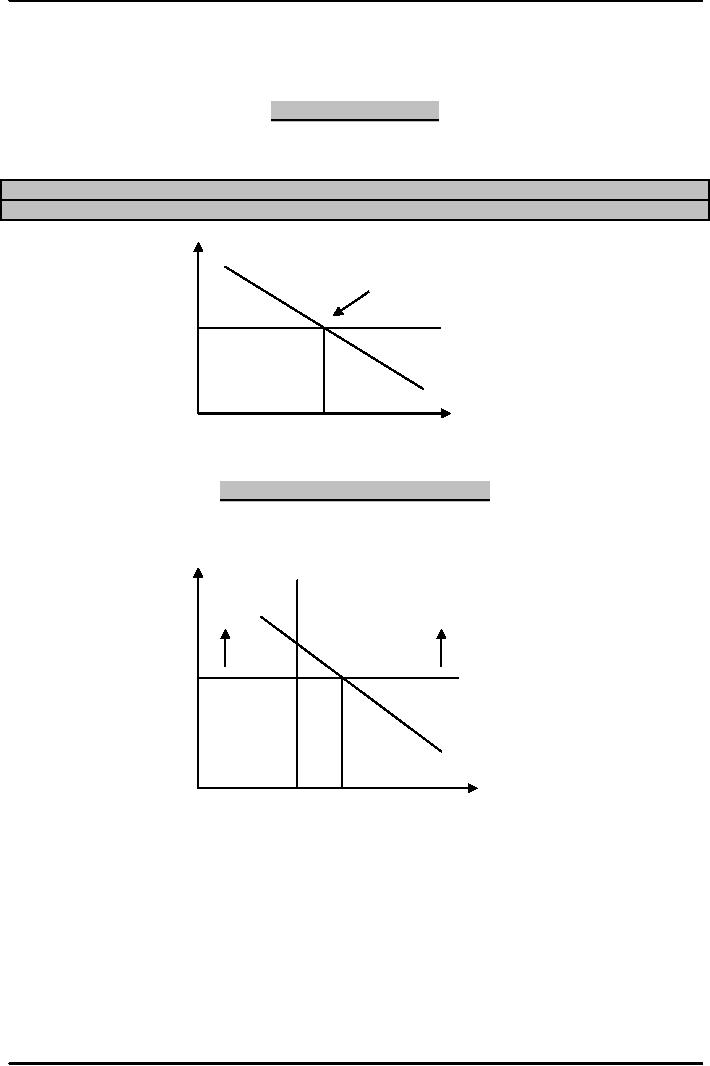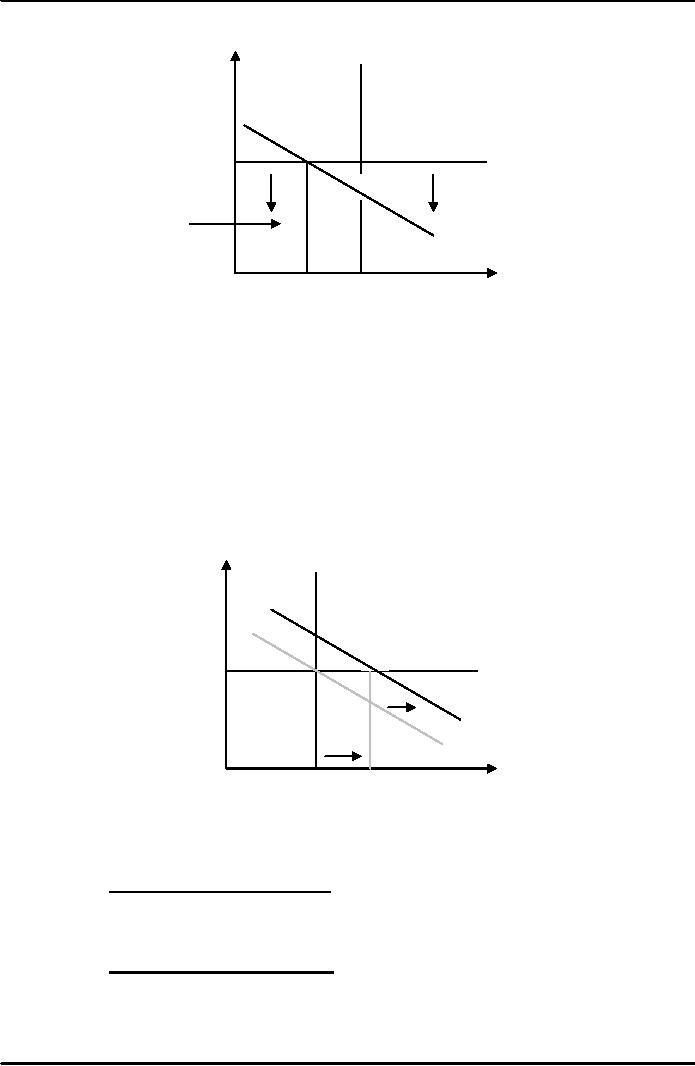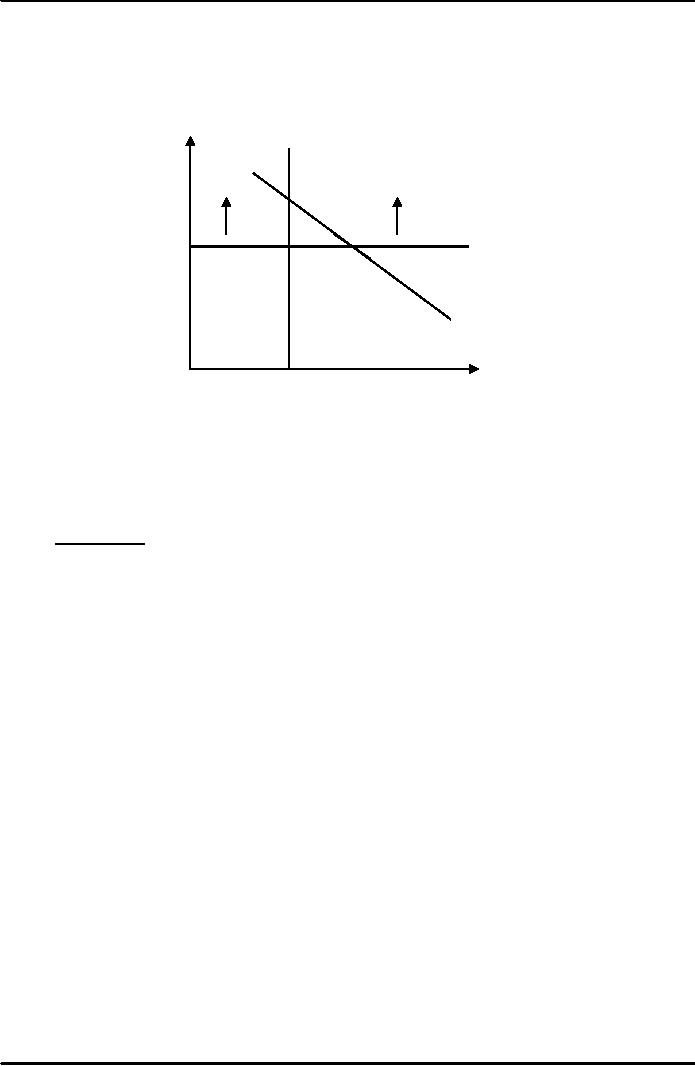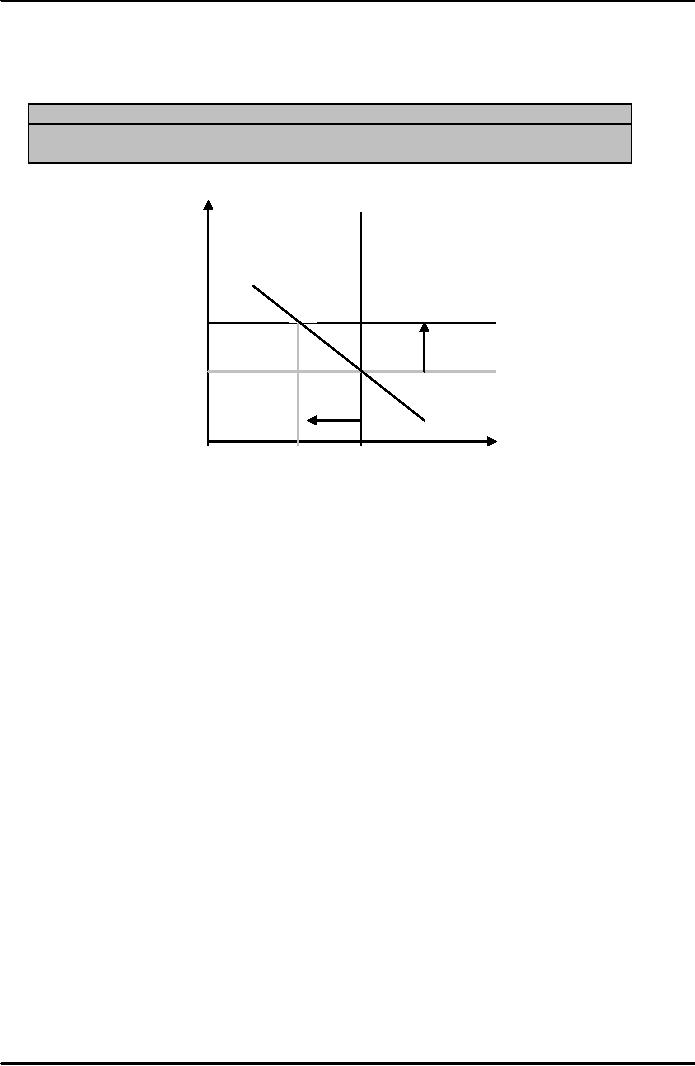 |
EQUILIBRIUM AND THE DETERMINATION OF OUTPUT AND INFLATION |
| << THE AGGREGATE SUPPLY CURVE:Inflation Shocks |
| SHIFTS IN POTENTIAL OUTPUT AND REAL BUSINESS CYCLE THEORY >> |

Money
& Banking MGT411
VU
Lesson
44
EQUILIBRIUM
AND THE DETERMINATION OF OUTPUT AND
INFLATION
Short-Run
Equilibrium
Short-run
equilibrium is determined by the
intersection of the aggregate demand
curve with the
short-run
aggregate supply
curve.
Figure:
Short Run Equilibrium of Output
and Inflation
Inflation
and actual output are determined by the
intersection of the SRAS curve
with the ADC
Inflation
(�)
Short
run Equilibrium
Current
SRAS
Inflation
ADC
Actual
Output
Output
(Y)
Adjustment
to Long-Run Equilibrium
When
current output exceeds
potential, the resulting expansionary gap
exerts upward
pressure
on
inflation, shifting the short-run
aggregate supply curve
upward, a process that continues
until
output
returns to potential; at this point
inflation stops
changing.
Inflation
(�)
LRAS
2
Current
1
Inflation
SRAS
Expansio
nary
Output
ADC
Gap
Potential
Current
Output
(Y)
Output
Output
If
current output is lower than
potential output, the resulting
recessionary gap places
downward
pressure
on inflation, causing the short-run
aggregate supply curve to
shift downward, and
once
again
the process continues until current
output returns to potential
139

Money
& Banking MGT411
VU
LRAS
Inflation
(�)
Current
1
Inflation
SRAS
2
Recessionary
ADC
Gap
Output
(Y)
Current
Potential
Output
Output
This
shows that the economy does
indeed have a self-correcting mechanism
and that the manner
in
which the short-run aggregate
supply curve shifts in
response to output gaps
reinforces our
conclusion
that the long-run aggregate
supply curve is
vertical
In
long-run equilibrium, current
output equals potential
output and current inflation is
steady
and
equal to target inflation, which
equals expected inflation
The
Impact of Shifts in Aggregate Demand on
Output and
Inflation
Suppose
aggregate demand shifted
right as a result of an increase in
government purchases.
At
first, current output rises
but inflation does not
change.
But
the higher level of output
creates an expansionary gap and the
short-run aggregate
supply
curve
starts to shift upward and
inflation rises
Inflation
(�)
LRAS
2
SRAS
Target
Inflation
(�T)
New
AD
Original
AD
Potential
Current
Output
(Y)
Output
Output
Short-Run
Equilibrium Inflation and
Output Following an Increase in Aggregate
Demand
1.
Start at Long-Run
Equilibrium
Y
= Potential Output
�
=
Target Inflation
2.
Aggregate Demand Shifts
Right
Original
AD shifts to New AD
Y
> Potential Output
Inflation
Is Unchanged
140

Money
& Banking MGT411
VU
Short-run
equilibrium moves from point
1 to point 2
Higher
inflation moves policymakers
along their reaction curve,
leading them to raise the
real
interest
rate and moving the economy upward along
the new aggregate demand
curve. Output
then
begins to fall back toward its
long-run equilibrium
level.
The
economy will settle at the point at which
the new aggregate demand
curve crosses the
long-
run
aggregate supply curve and
current output again equals
potential output
Inflation
LRAS
(�)
3
2
SRAS
Target
Inflation
(�T)
New
ADC
Potential
Output
(Y)
Output
Adjustment
of Short-Run Equilibrium Inflation
and Output Following an
Increase in Aggregate
Demand
Adjustment:
At
the Short-Run Equilibrium point
2:
Y
> Potential Output
SRAS
begins to shift up
Output
begins to fall
Inflation
begins to rise as economy moves along New
AD
With
no policy response, economy moves to
point 3, where Current inflation
>Target inflation
If
central bankers simply sit
and watch as the aggregate demand
curve shifts to the
right,
inflation
will rise
So
long as monetary policymakers
remain committed to their
original inflation target,
they will
need
to do something to get the economy back to the point where it
began--point "1"
An
increase in government purchases
raises the long term real
interest rate.
Policymakers
will compensate by shifting
their monetary policy
reaction curve to the
left,
increasing
the real interest rate at every level of
inflation
When
the monetary policy reaction
curve shifts, the aggregate
demand curve shifts with
it.
The
aggregate demand curve will
shift to the left, bringing the economy
back to long-run
equilibrium.
An
increase in aggregate demand
causes a temporary increase in
both output and
inflation.
A
decline in aggregate demand
causes a temporary decline in
both output and
inflation
This
discussion implies that
whenever we see a permanent increase in
inflation, it must be the
result
of monetary policy.
That
is, if inflation goes up or down and
remains at its new level,
the only explanation is
that
central
banker must be allowing it to
happen.
They
have changed their inflation
target, whether or not they
acknowledge the change
explicitly.
141

Money
& Banking MGT411
VU
The
Impact of Inflation Shocks on
Output and
Inflation
An
inflation shock shifts the
short-run aggregate supply
curve (such as an oil price
increase)
A
positive shock moves it to a
higher level, and the result
is higher inflation and lower
output, a
situation
called "stagflation".
Figure:
The Effects of a Positive
Inflation Shock on Short-Run
Equilibrium
A
positive inflation shock
shifts the short-run aggregate
supply curve upward,
moving
short
run equilibrium from point 1
to point 2. Inflation rises
and output falls.
Inflation
(�)
LRAS
2
New
SRAS
1
Old
SRAS
Target
Inflation
(�T)
ADC
Current
Potential
Output
(Y)
Output
Output
But
the decline in output exerts
downward pressure on inflation,
causing the short-run
aggregate
supply
curve to shift down
Inflation
falls and output rises until
the economy returns to the point where current
output
equals
potential output and inflation
equals the central bank's
target.
An
inflation shock has no
affect on the economy's long-run
equilibrium point; only a
change in
Potential
output or a change in the central
bank's inflation target can
accomplish that.
142
Table of Contents:
- TEXT AND REFERENCE MATERIAL & FIVE PARTS OF THE FINANCIAL SYSTEM
- FIVE CORE PRINCIPLES OF MONEY AND BANKING:Time has Value
- MONEY & THE PAYMENT SYSTEM:Distinctions among Money, Wealth, and Income
- OTHER FORMS OF PAYMENTS:Electronic Funds Transfer, E-money
- FINANCIAL INTERMEDIARIES:Indirect Finance, Financial and Economic Development
- FINANCIAL INSTRUMENTS & FINANCIAL MARKETS:Primarily Stores of Value
- FINANCIAL INSTITUTIONS:The structure of the financial industry
- TIME VALUE OF MONEY:Future Value, Present Value
- APPLICATION OF PRESENT VALUE CONCEPTS:Compound Annual Rates
- BOND PRICING & RISK:Valuing the Principal Payment, Risk
- MEASURING RISK:Variance, Standard Deviation, Value at Risk, Risk Aversion
- EVALUATING RISK:Deciding if a risk is worth taking, Sources of Risk
- BONDS & BONDS PRICING:Zero-Coupon Bonds, Fixed Payment Loans
- YIELD TO MATURIRY:Current Yield, Holding Period Returns
- SHIFTS IN EQUILIBRIUM IN THE BOND MARKET & RISK
- BONDS & SOURCES OF BOND RISK:Inflation Risk, Bond Ratings
- TAX EFFECT & TERM STRUCTURE OF INTEREST RATE:Expectations Hypothesis
- THE LIQUIDITY PREMIUM THEORY:Essential Characteristics of Common Stock
- VALUING STOCKS:Fundamental Value and the Dividend-Discount Model
- RISK AND VALUE OF STOCKS:The Theory of Efficient Markets
- ROLE OF FINANCIAL INTERMEDIARIES:Pooling Savings
- ROLE OF FINANCIAL INTERMEDIARIES (CONTINUED):Providing Liquidity
- BANKING:The Balance Sheet of Commercial Banks, Assets: Uses of Funds
- BALANCE SHEET OF COMMERCIAL BANKS:Bank Capital and Profitability
- BANK RISK:Liquidity Risk, Credit Risk, Interest-Rate Risk
- INTEREST RATE RISK:Trading Risk, Other Risks, The Globalization of Banking
- NON- DEPOSITORY INSTITUTIONS:Insurance Companies, Securities Firms
- SECURITIES FIRMS (Continued):Finance Companies, Banking Crisis
- THE GOVERNMENT SAFETY NET:Supervision and Examination
- THE GOVERNMENT'S BANK:The Bankers' Bank, Low, Stable Inflation
- LOW, STABLE INFLATION:High, Stable Real Growth
- MEETING THE CHALLENGE: CREATING A SUCCESSFUL CENTRAL BANK
- THE MONETARY BASE:Changing the Size and Composition of the Balance Sheet
- DEPOSIT CREATION IN A SINGLE BANK:Types of Reserves
- MONEY MULTIPLIER:The Quantity of Money (M) Depends on
- TARGET FEDERAL FUNDS RATE AND OPEN MARKET OPERATION
- WHY DO WE CARE ABOUT MONETARY AGGREGATES?The Facts about Velocity
- THE FACTS ABOUT VELOCITY:Money Growth + Velocity Growth = Inflation + Real Growth
- THE PORTFOLIO DEMAND FOR MONEY:Output and Inflation in the Long Run
- MONEY GROWTH, INFLATION, AND AGGREGATE DEMAND
- DERIVING THE MONETARY POLICY REACTION CURVE
- THE AGGREGATE DEMAND CURVE:Shifting the Aggregate Demand Curve
- THE AGGREGATE SUPPLY CURVE:Inflation Shocks
- EQUILIBRIUM AND THE DETERMINATION OF OUTPUT AND INFLATION
- SHIFTS IN POTENTIAL OUTPUT AND REAL BUSINESS CYCLE THEORY